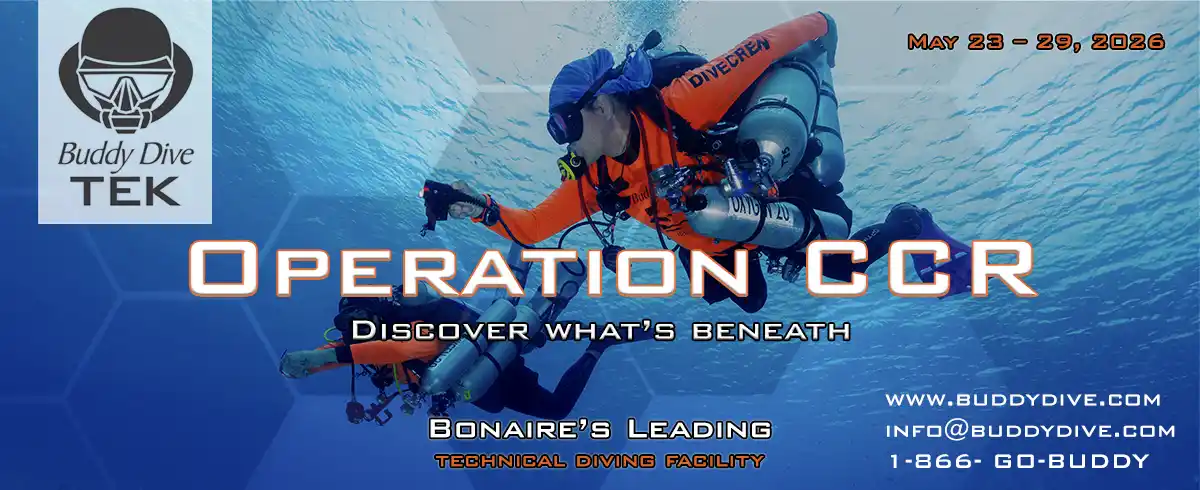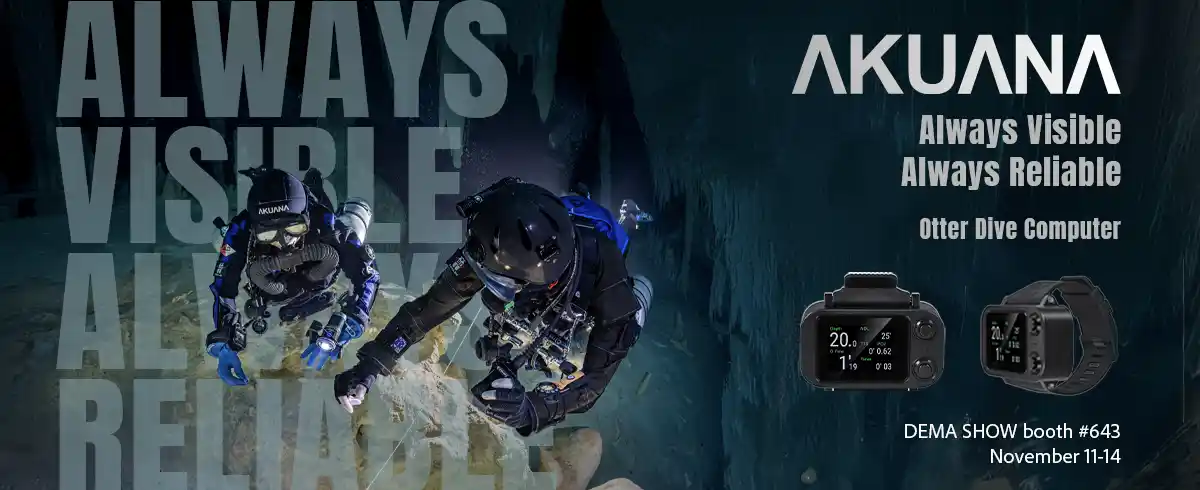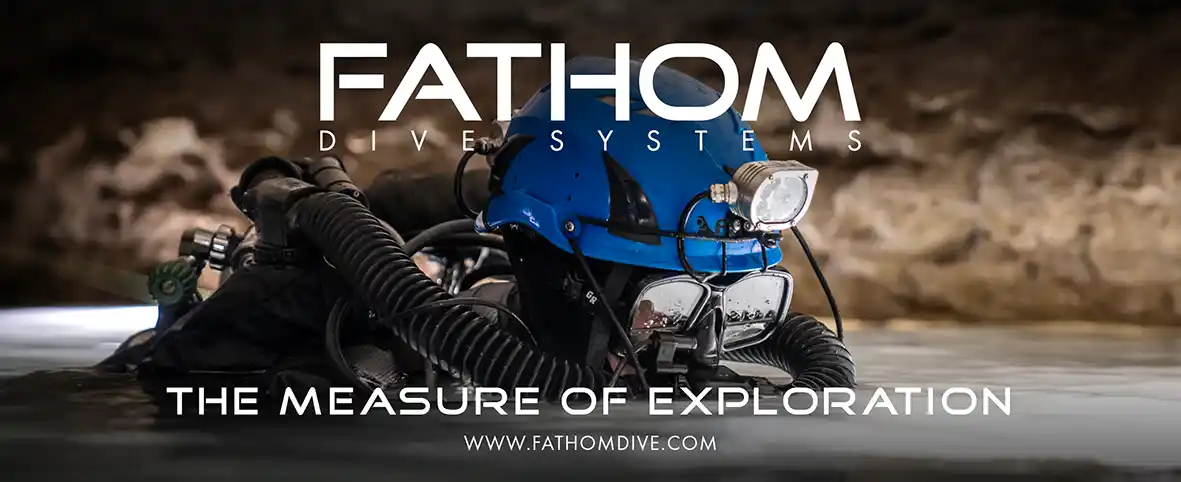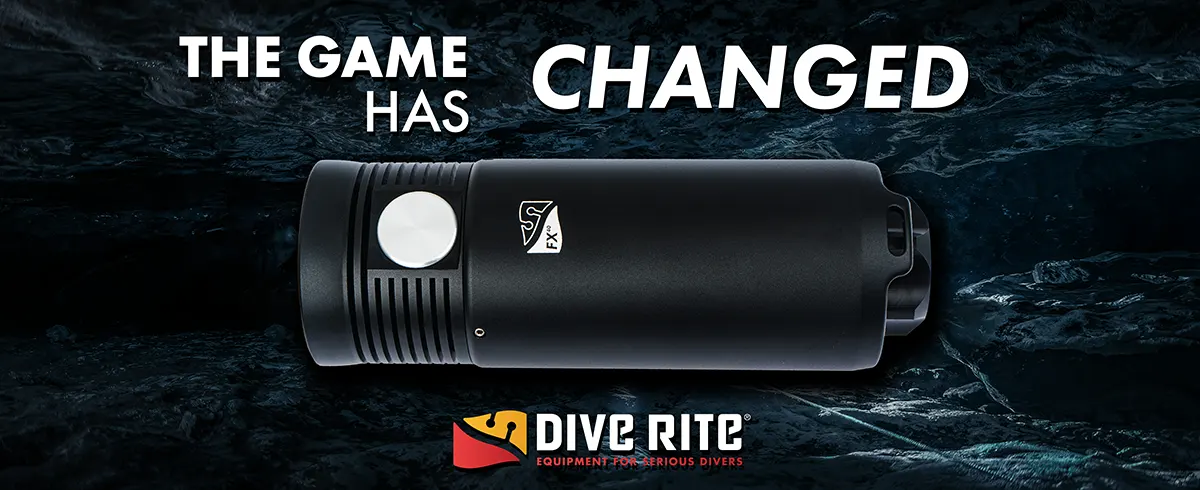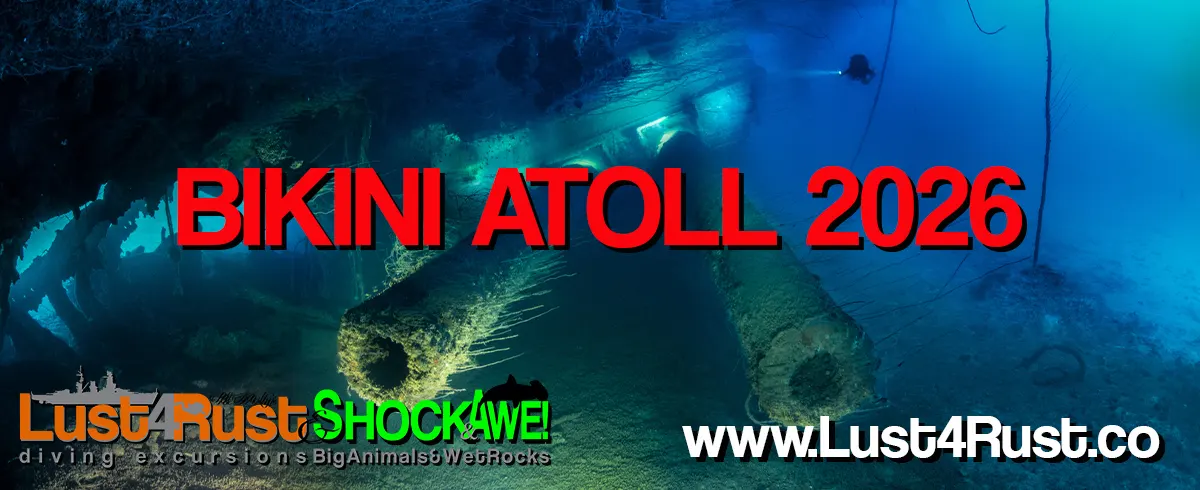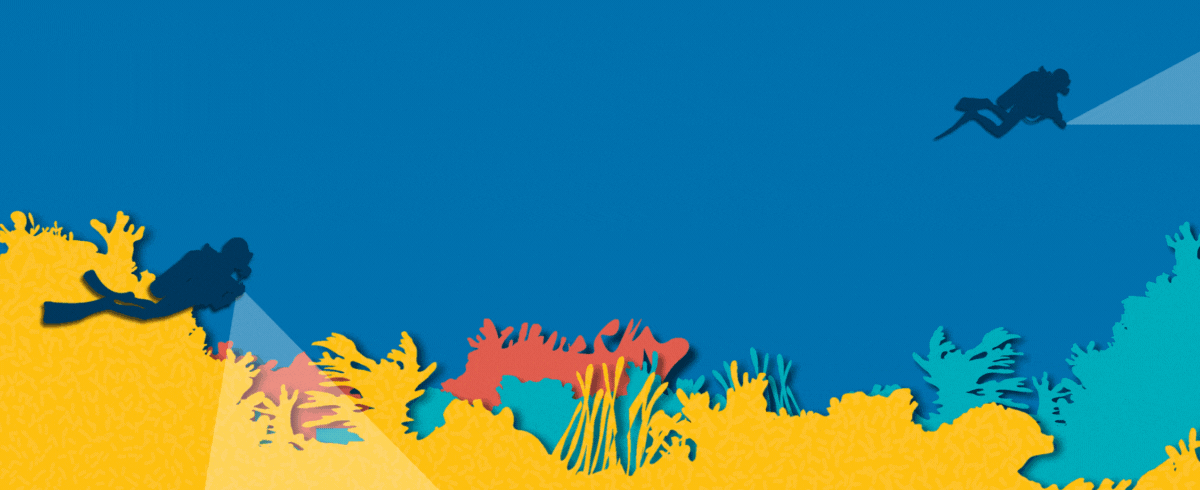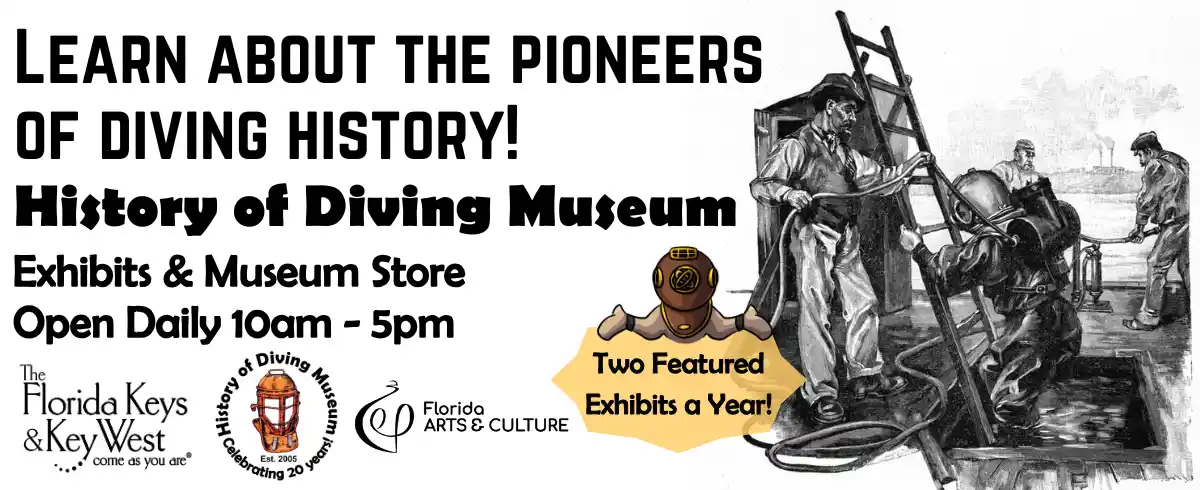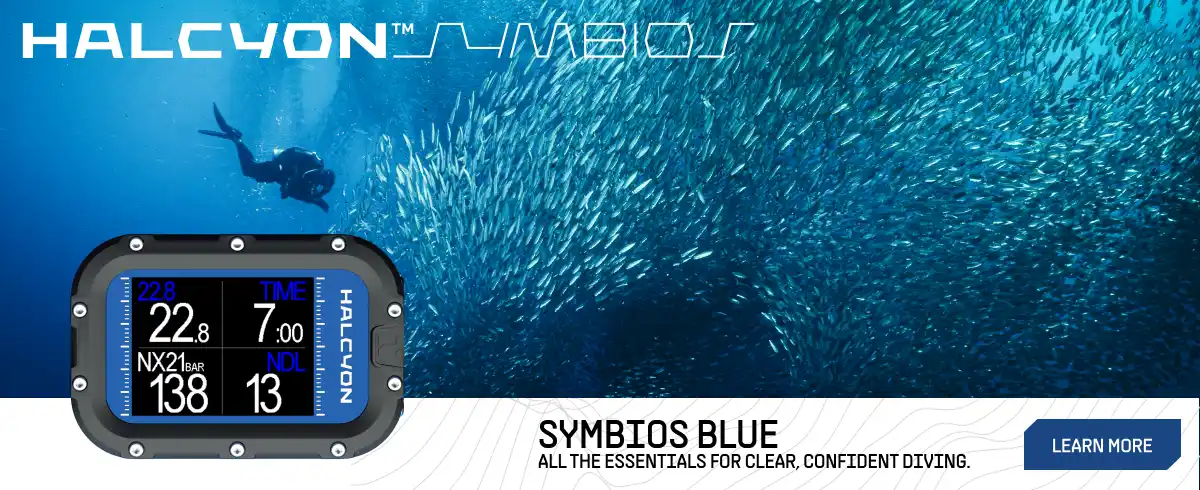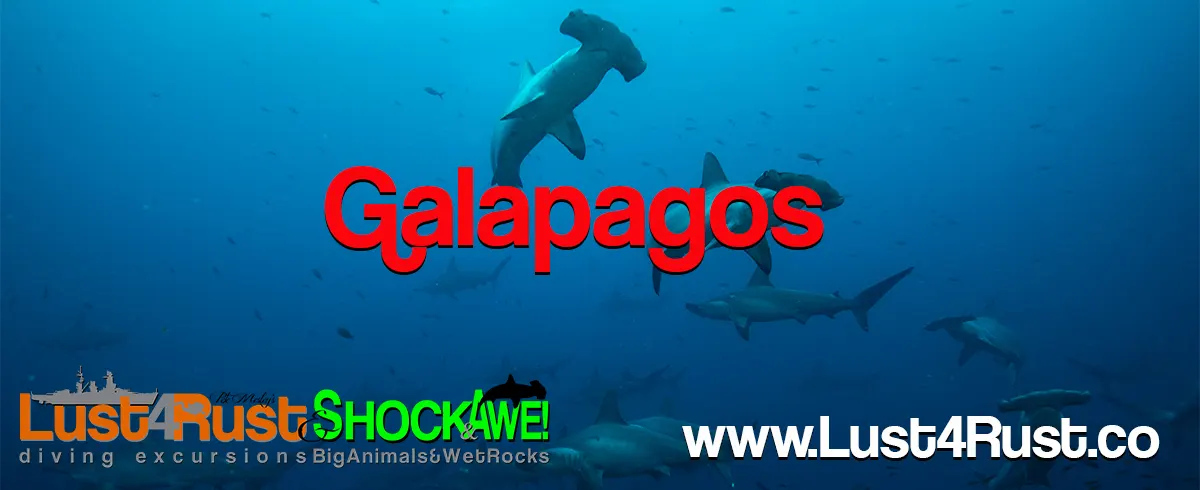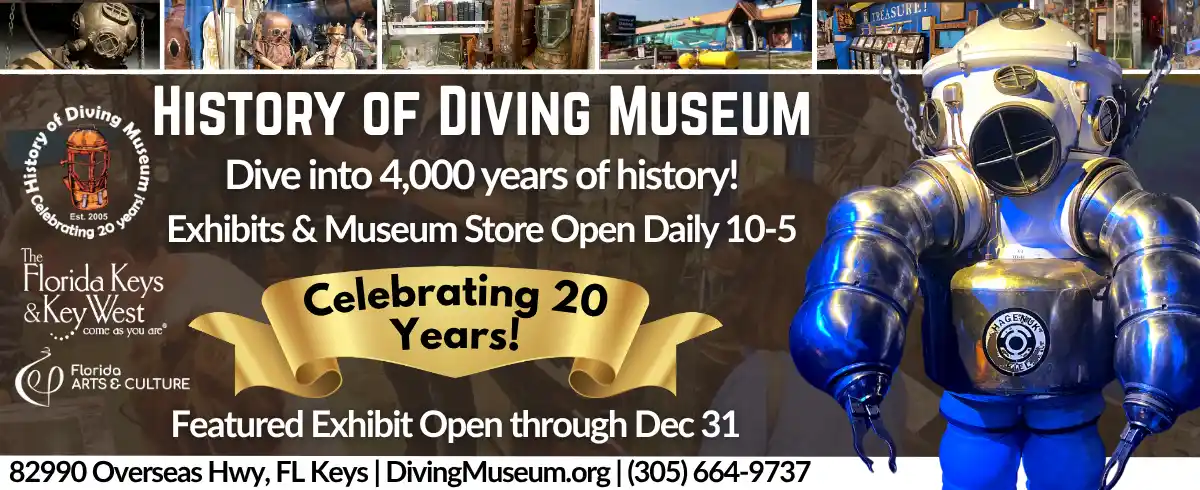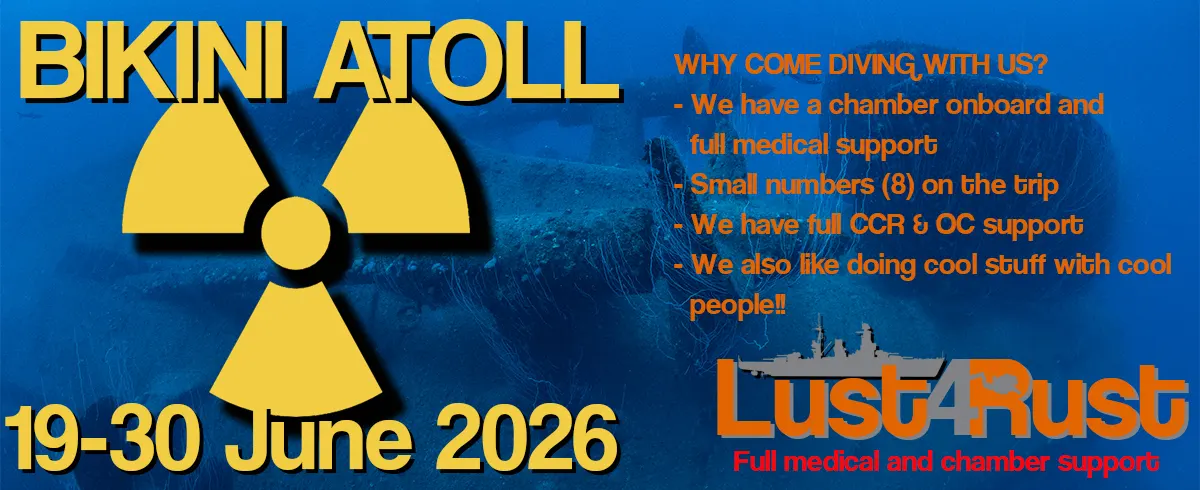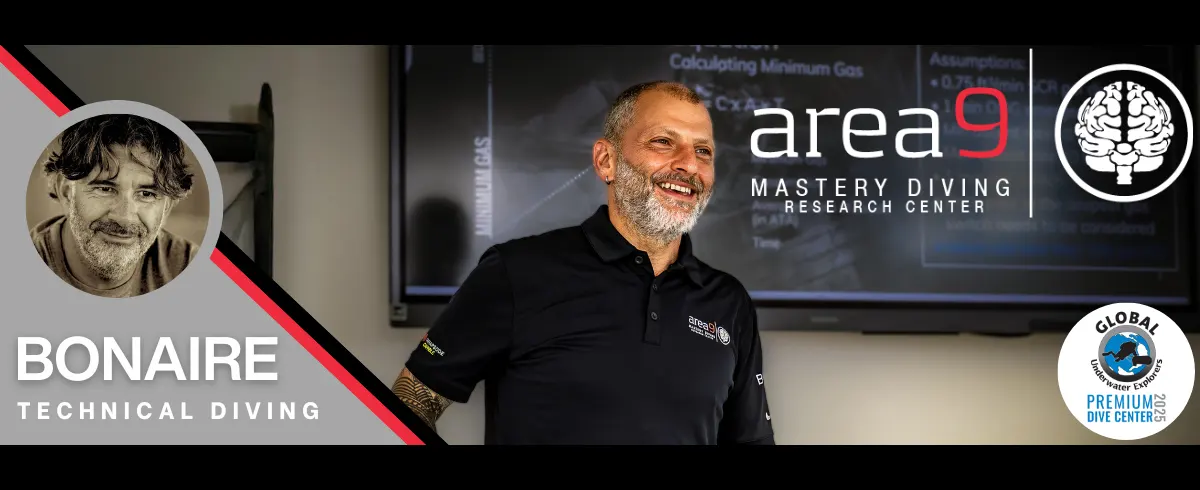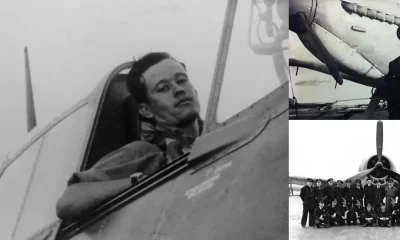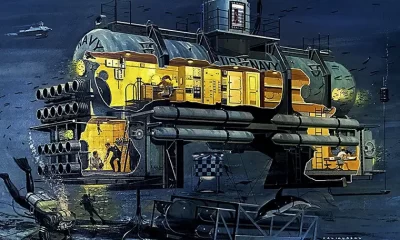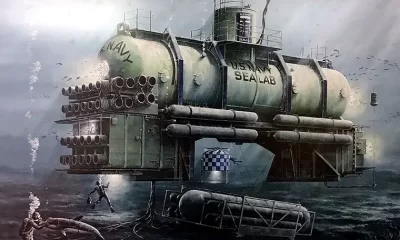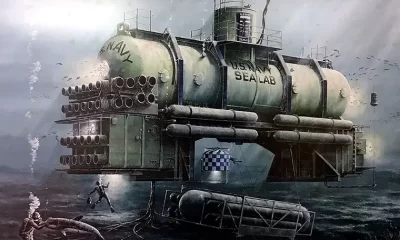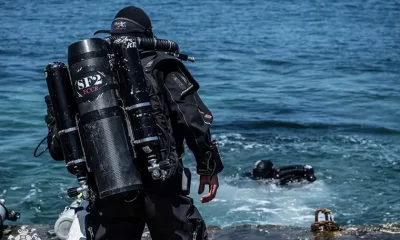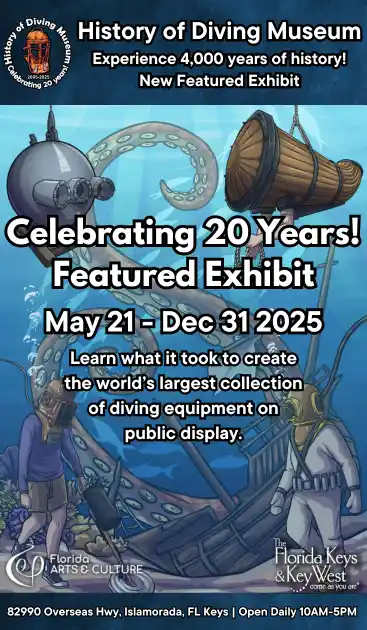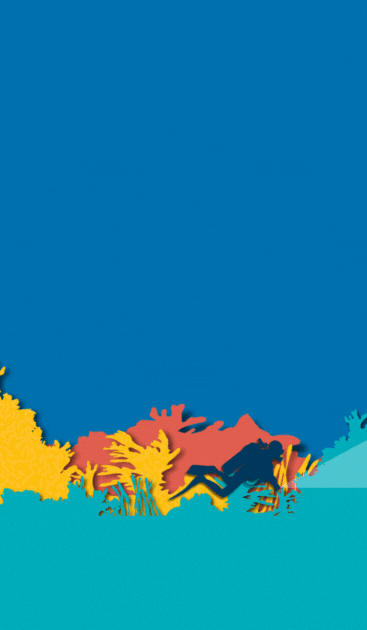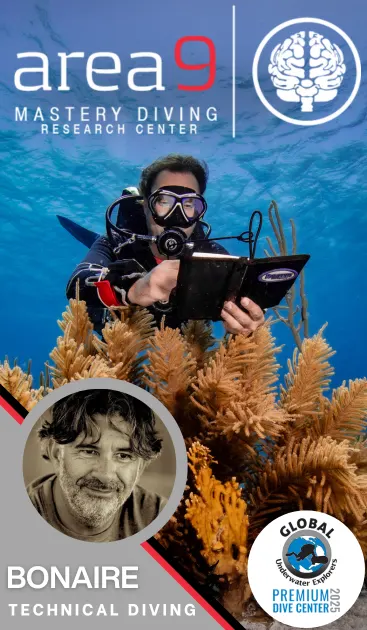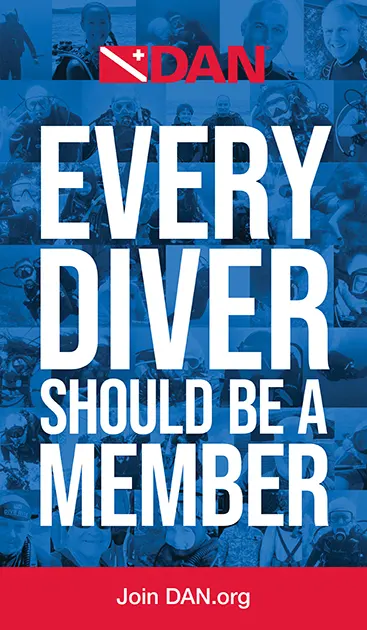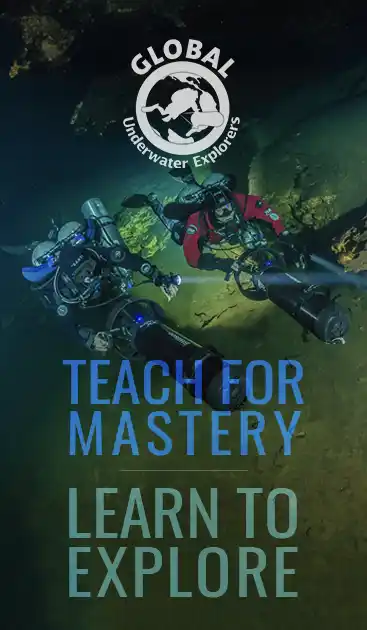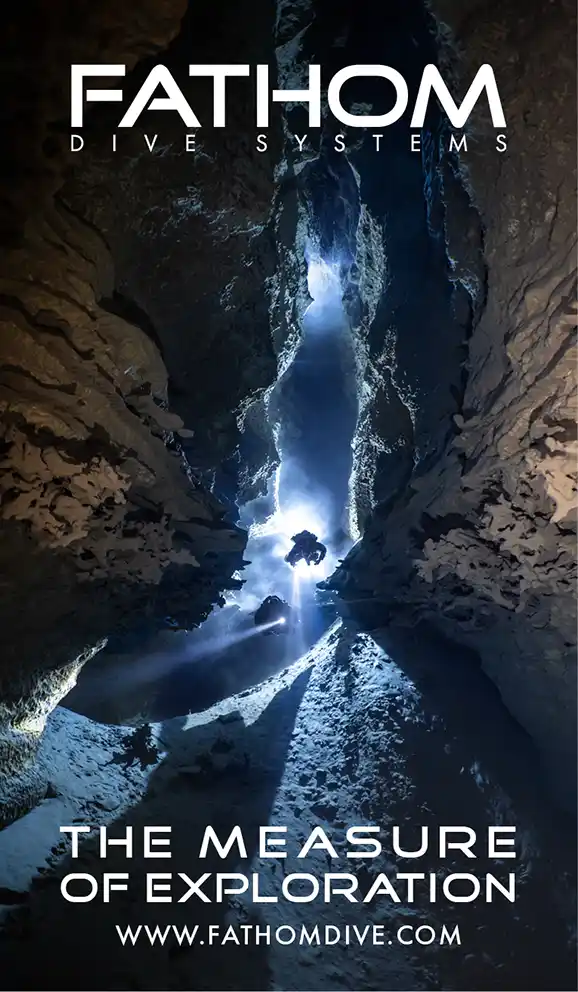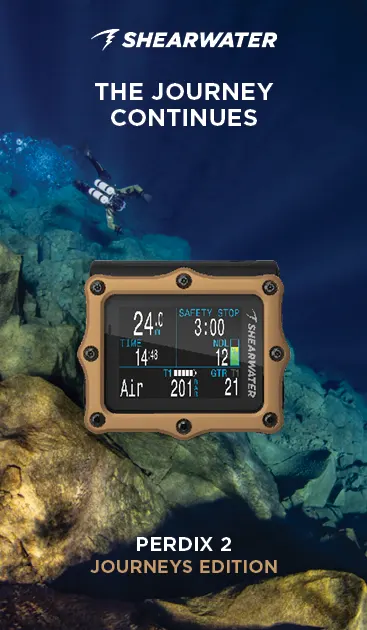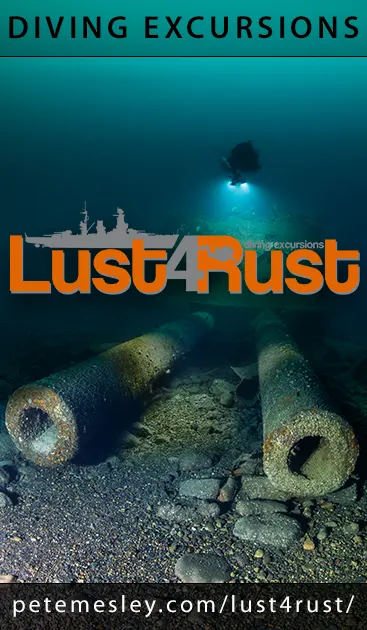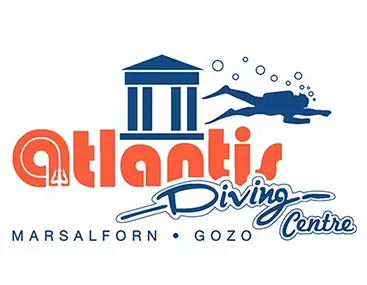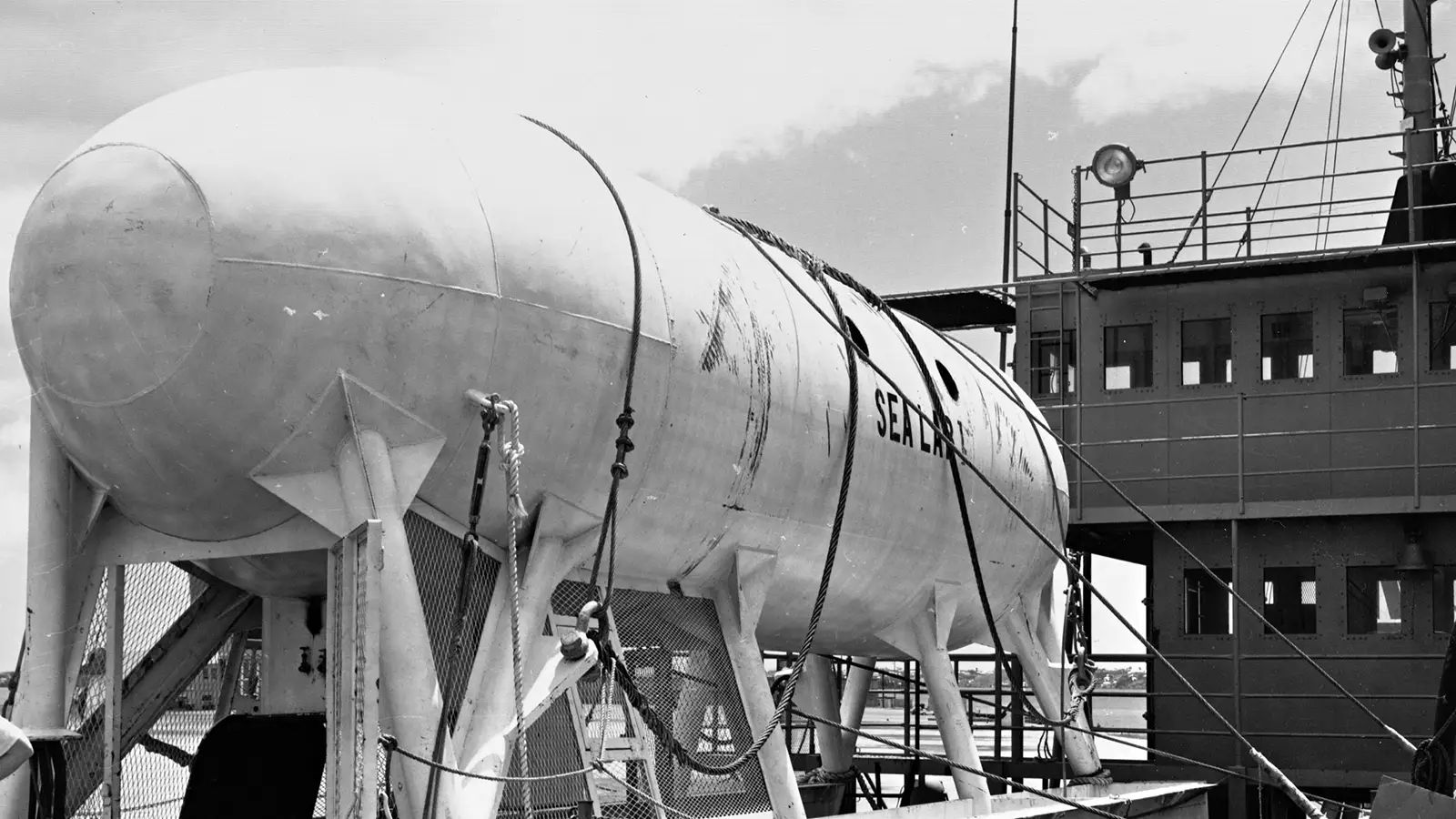
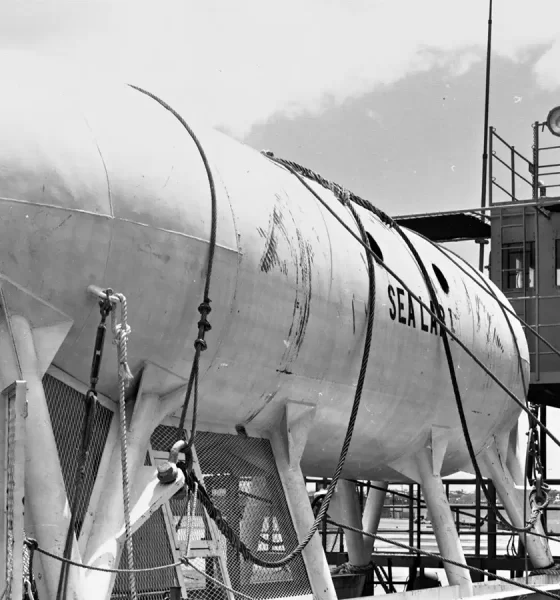
History
Remembering Sealab I
Sixty years ago next month, four U.S. Navy divers—the first American aquanauts—swam into a seafloor shelter dubbed Sealab I, stationed 59m/193 ft deep, 42 km/25 mi southwest of the U.S. Navy base at Bermuda. Their goal was to prove that divers could not only go deeper, they could also stay down far longer than ever thought possible, in what would become known as “saturation diving.” Here, on the eve of its 60th anniversary, is the story of Sealab I and its successors, as told by journalist and author Ben Hellwarth.
By Ben Hellwarth. Photos courtesy of the US Navy and former US Navy diver/photographer Bernie Campoli who was on the Sealab I team, as noted. Lede photo: Sealab I on a barge waiting to be deployed.
Something that happened 60 years ago, nearly 61 meters/200 feet below the surface of the Atlantic, might have been a worthy cause for celebration. Maybe public displays like those ticker-tape parades being held for the first American astronauts—the dauntless pioneers who had deservedly become ubiquitous in the media of the day, including a relatively new entrant known as TV news.
The space race with the Soviets was on, and the American Mercury Seven astronauts led the charge—their exalted place in history was further assured by Tom Wolfe’s pithy encapsulation of their rocket-riding exploits and personal je ne sais quoi as a pure show of The Right Stuff. The inimitable journalist’s mega-selling classic was a rollicking romp of nonfiction and soon made a giant leap to the silver screen, further enshrining the right stuff, lowercase, into the popular lexicon as a descriptor for the kind of steely competence associated with test pilots and the first spacemen.
In July of 1964, about a year after the last of the much-heralded Project Mercury space flights, something equally incredible happened–not in space but deep in the Atlantic Ocean—and it required some of that same right stuff, as well as a modicum of grit, bricolage, and corner-cutting (making up for the lack of abundant government funding that fairly gushed into NASA and the space program).
Four U.S. Navy divers—the first American “aquanauts”—swam into a specially outfitted, if somewhat homemade looking, sea-floor shelter dubbed Sealab I. They began what a close-knit group of Navy scientists and divers believed would be a game-changing foray into manned undersea activities—for the military, for industry, for science, for anyone who dreamed of living and working beneath the waves.

The goal was to prove that divers could not only go deeper, they could also stay down far longer than ever thought possible—for hours, days, weeks, even months instead of the mere minutes that standard diving methods allowed, especially once divers reached depths of about 46 m/150 ft or more. This breakthrough could do for diving what supersonic flight did for aviation.

But unlike the rocket launches and splash downs of those years, neither the opening nor the conclusion of this inaugural Sealab received comparable headlines, accolades or parades. Yet many of the same newsworthy elements were in play: Risks. Firsts. Opening doors to new frontiers. All remarkable displays of the right stuff.
So even if the 60th anniversary of Sealab I goes largely unrecognized around the Blue Planet, it’s at least a milestone that divers—commercial, military, scientific, recreational—should want to mark on their calendars.

It’s Bond, George Bond
Back in the 1960s, the goal for the astronauts, as articulated by President John F. Kennedy, was to land on the moon. The goal for their undersea counterparts—the aquanauts, as some had taken to calling divers equipped to live and work in the sea—well, that goal was a little less specific and gained far less attention, in no small part because far fewer taxpayer dollars were pouring in to achieve it. Still, the spirit of the Sealab program was much the same as that of the space program, although that spirit did not arise out of a presidential directive or a national obsession with beating the Russians. Sealab sprouted more discreetly in the fertile imagination of a Navy doctor named George F. Bond, who gained a reputation for being a leader, and diver, who wouldn’t ask anyone to take risks that he wouldn’t take himself—a key quality for what lay ahead.
For the first years of his medical career, Dr. Bond would have seemed an unlikely champion for deeper diving and sea-floor bases. After medical school, Bond decided to pass up more lucrative opportunities at city clinics and opted instead to go it alone as a country doctor. Beginning in the mid-1940s, Bond served a far-flung backwoods community in the Blue Ridge Mountains, in a corner of western North Carolina where he had spent time as a boy and saw for himself the remote region’s need for physicians.
This was of course miles from the ocean, and the ocean was miles from Bond’s thoughts until the early 50s when he got called up to join the Army, and a bureaucratic hiccup got him routed into the Navy instead. His training to become a submarine medical officer included learning how to dive, which meant using the traditional “hardhat” system with the Navy’s iconic and bulbous Mark V helmet affixed to a heavy, rubber-lined canvas suit. Compressed air was pumped in by hose from the surface. New to Navy dive lockers at that time was self-contained underwater breathing apparatus, the kind of SCUBA recently developed by a rising oceanographic star named Jacques-Yves Cousteau, along with a fellow Frenchman, the engineer Emile Gagnan.

Bond was a preternaturally adventurous soul, and he liked the new experience of diving. As a scientist, he also found the underlying physiology and medicine of diving fascinating. Most intriguing, perhaps, was that at the dawn of the space age, with the sky no longer the limit, divers were still largely abiding by limits established decades before. Whether you were doing a job in heavy hardhat gear, taking care not to snag your air hose, or whether you were swimming freely in modern scuba, with air tanks on your back, the same conventional limits applied: You couldn’t dive very deep, and if you did venture much below, say, a couple of hundred feet, you couldn’t stay down for very long.
During the historic rescue and salvage of the American submarine Squalus, for example, which sank in 1939 in Atlantic waters of about 73 m/240 ft, Navy divers could spend no more than about a half an hour at the downed sub before they had to begin the gradual process of decompression required for a safe return to the surface. Therefore, it took dozens of divers and multiple dives to put in the hours needed to get a difficult job done. When Dr. Bond arrived on the diving scene, that was still pretty much the state of the art.
Decompression schedules, also known as dive tables, had been worked out in the early 20th century to prevent divers from getting “the bends,” the painful and potentially fatal condition brought about if a diver surfaced too quickly, causing bubbles to form in the body much as they do in a can of soda that’s popped open. Those bubbles, in turn, could cause all manner of physiological short circuits, injuries, even death, depending on where they appeared.
Dive tables were always being refined to maximize dive times and minimize decompression times while keeping a diver safe and free of the bends. But these refinements were more like tinkering than a total transformation, and Bond marveled that with the world fixated on the lofty goal of sending human beings into outer space and to the distant moon, there was no similar, well-funded government effort to send human beings in the other direction, deeper into the realm that some liked to call “inner space,” perhaps because that label might siphon a little attention from the (outer) space program.

In addition to the bends, there was the pesky phenomenon known as nitrogen narcosis, the drunken stupor many divers experience at depths of more than about 40 m/130 ft when breathing the nitrogen that makes up four-fifths of atmospheric air. The narcotic effects of nitrogen had successfully been eliminated a couple of decades earlier by substituting helium into a diver’s breathing gas. That enabled divers to stay clear headed when diving deeper—a critical improvement, especially on tricky jobs—yet both depth and duration remained restricted by conventional limits, as set forth in the dive tables.
So, while diving had made some progress, Bond nonetheless found it surprising that no one had the answer to a pair of questions that seemed to him as fundamental as knowing the speed of sound or how fast a human could run the mile: How long can a diver stay down? How deep can a diver go?
How long can a diver stay down? How deep can a diver go?
After serving in the Navy for several years, Bond could have returned to his rural medical practice, and he almost did. But he had become hooked on diving and intrigued by the prospect of achieving breakthroughs that would somehow get around the old decompression limits and afford divers a lot more time underwater. So Bond continued to pursue a career as a Navy medical officer, and he would make it his job to seek answers to those lingering questions about dive depth and duration.

Saturation Diving, Anyone?
Commander Bond soon got promoted to Captain and became Officer-in-Charge of the Medical Research Laboratory at the U.S. Naval Submarine Base at New London, Connecticut. It was there, in the late 1950s, that he would begin the laboratory experiments aimed at proving the concept of “saturation diving,” a term that referred to allowing a diver’s body to fully absorb the gasses breathed at a given depth, similar to how a sponge absorbs liquid. The greater the depth and pressure, the greater the degree of saturation. The conventional approach to diving didn’t actually allow enough time for a diver to become saturated, and results of some preliminary lab experiments that did allow for total saturation took about a day at a given depth and indicated that allowing for total saturation might not solve the depth or duration problems. It could even be downright dangerous.
Nevertheless, Captain Bond and a few others around the New London lab believed that saturation diving could hold the key to enabling a diver to spend indefinite periods at depth. There would still be no getting around the need to decompress, but that cumbersome process might be postponed indefinitely, affording divers far more time underwater for the trouble it took to decompress. That was the idea, anyway. To test it out Bond and his team at the lab would begin running experiments on assorted animals, much as tests were run on animals in the early years of the space program before humans with the right stuff were allowed to ride rockets into the sky.
The early experiments on saturation diving began quietly, even unofficially, in stark contrast to the animal experiments for the space program—monkeys like Able and Baker made the cover of Life magazine. For a time Bond’s Navy bosses weren’t entirely aware what he was up to in his lab, and Bond knew that some would not have approved. But his iconoclastic streak could serve him well. He was determined to gather favorable evidence and generate enthusiasm for the revolutionary prospects of saturation diving, which got shortened to “sat diving”—a familiar term to professional divers, if not others.
Favorable results from the animal tests led to a new round of experimentation. This time, like the animals, human volunteers would be sealed in hyperbaric chambers, with scant amenities, and subjected to a pressurized environment similar to what they’d live in underwater. That meant breathing newly concocted gas mixtures very different from the roughly 79 percent nitrogen and 20 percent oxygen found in Earth’s breathable air. It also meant being exposed to heightened pressure for much longer than anyone usually was. About a week was the initial goal.
Those volunteers in the chamber would also know that, once saturated, there was no quick way out before undergoing a lengthy and carefully orchestrated decompression. There would also be no way to be sure that the customized gas mixtures and decompression schedules that seemed to work for rats, monkeys, or goats would be safe for humans. In short, there was no guarantee that those locked into a chamber would come out alive. The volunteers would surely need some strain of the right stuff—along with considerable faith in Captain George Bond.

Even as the tests were going on, Bond was looking ahead to the next step: How to persuade the Navy to build a first prototype sea-floor station. If divers were to spend days or weeks on the seabed instead of mere minutes, they’d need a shelter of some kind, an undersea version of a space station. And they had to find out whether the methods that seemed to work in the lab would work at sea, with all the variables and challenges that come with operating in the fickle marine environment.
In the meantime Bond was happy to share the promising results he was getting in the lab; a report on the animal experiments, while not widely distributed, was publicly available. Two prominent figures in undersea exploration were intrigued. One was the American industrialist Ed Link, inventor of the first flight simulator, who was turning his attention from aviation to diving and ocean-going technologies.
The other was Jacques Cousteau, co-developer of modern scuba, who was fast becoming a household name. The two were initially going to join forces to run a first saturation dive at sea, then their relations soured and they went ahead separately instead, with two saturation trials each, between 1962 and 1964. Both took relatively cautious approaches, with Link more focused on achieving depth and Cousteau more focused on duration. Bond and his Navy team were aiming for a more definitive demonstration of the prospects for achieving both, substantially greater depth and duration.

Sealab I
By early 1964, the Navy agreed to build Sealab I, its first-ever undersea “habitat.” The Roman numeral optimistically suggested that this habitat would not be the last. But a lot was riding on how this undersea debut turned out. Sealab I was about 12m/40 ft long and 2.7 m/9 ft in diameter. It weighed 27.2k metric tons/30 tons and had multiple legs, like those on a dining table, so that the structure stood about 2m/6 ft over the seabed. The habitat was pieced together at the Navy base in Panama City, Florida, its design largely a product of brainstorming sessions among a few engineers with guidance from Captain Bond and his team from the New London lab. Making Sealab I required a certain amount of scrappy creativity, both because they were building something the Navy had never built, and because they had to build it on a shoestring budget—one reason that the submarine-shaped hull of Sealab I was welded together from old floats that Bond found in a salvage yard.
The interior of Sealab I had the basic facilities of a camper – toilet, shower, stovetop, table, chairs, bunks. Four or five divers at a time could live in this novel Sealab, and what was most important was that they could make dives outside, at any time of day or night, because the habitat was designed to be pressurized to match the pressure of the surrounding water, just like the test chambers in the lab. That meant a hatch in the floor could remain open and the seawater would stop just below the brim. Once safely acclimated to the pressure, and to the customized mix of breathing gasses circulated through the habitat, the divers could live there indefinitely, don and doff their gear, and come and go as they pleased. That was the concept, anyway, of combining the new method of saturation diving with this prototypical sea dwelling.

This concept would be put to the test at a site about 40 km/25 miles southwest of the U.S. Navy base at Bermuda. Once towed out to the site, Sealab I was lowered to a depth of 59m/193 ft, close to the benchmark of 200 feet used in the final lab experiments. It was a substantial depth, then and even today. Picture a 20-story building, with the water pressure at such depth being seven times what it is at sea level. At least as challenging as the depth was the planned duration: The goal was to house four aquanauts in Sealab for three weeks—a truly unprecedented, off-the-charts duration at such a depth. In addition to living inside Sealab, the aquanauts, also known as saturation divers, could drop through the open hatch in the floor directly into the water at a sandy expanse of seabed called Plantagenet Bank. They would be able to dive for hours in an area which, if reached on a conventional dive, they’d have to leave within a matter of minutes to begin their required decompression and gradual return to the surface.
On July 20, 1964, a date not found in many history books, four U.S. Navy divers squeezed into a capsule that was like a pressurized elevator, a prototype for getting saturation divers to and from the seabed. The capsule was lowered like bait on a fishing line to the vicinity of Sealab I. One after the other, the aquanauts took a deep breath, dropped through the open hatch in the capsule floor and made a free swim of 20 yards or so to the hatch in the underbelly of the habitat. Those first four aquanauts were Chief Quartermaster Robert A. Barth, who had been a test subject through all the human phases of the lab experiments, along with Gunner’s Mate 1st Class Lester “Andy” Anderson, Chief Hospital Corpsman Sanders “Tiger” Manning and Lt. Cmdr. Robert Thompson, a doctor, like Bond, in the U.S. Navy Medical Corps. Bond thought it wise to have a doctor on board.
The names and faces of Bob Barth, Andy Anderson, Tiger Manning and Bob Thompson would never be as readily recognizable as those of the Mercury Seven astronauts who had been introduced to the world a few years earlier with great fanfare, and who became favorite media subjects. One of the seven was a Navy pilot named Lt. Cmdr. Scott Carpenter, who would earn the distinction of being the second American astronaut to orbit the Earth, in May of 1962.

Carpenter, always on the lookout for challenges, caught wind of Sealab and wanted in on the adventure, recognizing that it had all the difficulty, risk and potential of his spaceflight. He got introduced to Captain Bond, who was happy to have a world-famous astronaut on board, knowing it might even help raise the program’s low profile. So Carpenter would have been crammed into the capsule with the other four aquanauts that day in July, if not for the scrapes and broken bones he sustained in a motorbike crash during Sealab preparations in Bermuda. Carpenter was genuinely disappointed not to be able to take his place in Sealab I, but if things went according to plan, he might still get a shot at living and working in the sea during a future phase of Sealab.
Once everyone was safely inside Sealab I, they all sounded like Donald Duck. This was because the Sealab atmosphere was rich in helium – anyone who has ever taken a breath from a party balloon has experienced the comical effect of helium on the vocal cords. At this depth of nearly 200 feet, having more helium than nitrogen in the mix was crucial for keeping the aquanauts sane and clear-headed, as on conventional dives. But would it be safe to breathe all that helium for, say, days? In the lab, that had been one of the many questions Bond and his team considered, as best they could.
So along with all the other challenges, they’d have to contend with helium’s speech-garbling effect. Four-letter words were readily comprehensible, but for more complex communications, the aquanauts would often write notes to each other. An intercom connected the sea dwellers with the surface, as well as a device called an Electrowriter, which transmitted facsimiles of hand-written messages to Bond and his team on the support ship, a repurposed Navy freight barge – another product of the shoestring budget. It served as a floating mission control, and it fed the habitat with fresh water, power and breathing gas. Looking to the future they hoped to make sea-based habitats more autonomous, able to sustain themselves without lines to the surface, but for the time being, this was the state of the art.

Maintaining the artificial atmosphere inside the habitat was a prime concern. The gas mixture was about 79 percent helium, 17 percent nitrogen, 4 percent oxygen and less than 0.5 percent carbon dioxide, a significantly different recipe from the 78 percent nitrogen and 21 percent oxygen in atmospheric air. Oxygen itself becomes toxic under pressure—yet another danger—so it has to be carefully reduced in the mix. Any significant deviations from the desired gas mixture could prove injurious, if not fatal.
Once the aquanauts were fully saturated and acclimated, which took about a day, a swim to the surface for any reason was not an option. The sudden drop in pressure en route to the surface would release all the gasses absorbed into the blood and tissues. They’d be dead before they got there, from a severe case of the bends, aptly and hauntingly known as “explosive decompression.”

Once settled into the steamy, helium-rich confines of Sealab I, the four aquanauts could cook canned foods on the electric stovetop, but frying was verboten – too much risk of contaminating the internal atmosphere. For their dives they had several kinds of gear to choose from, the most advanced of which was a rebreather called the Mark VI, which recycled a lot of the diver’s exhalations, thus affording longer dive times than ordinary scuba. But the gear, which looked similar to scuba, had to be precisely set up and it could be finicky. Once the Mark VI was set up, the diver would know approximately how long his gas supply would last. Approximately was an operative word, and since the gear had no warning systems, a diver had to be on constant alert for subtle signs of trouble—like overly labored breathing or lightheadedness. If he thought he was having a problem he couldn’t tell anyone since there was no means of voice communication while in the water, only old-fashioned hand signals. In an emergency, since immediate surfacing was not an option, a saturated diver’s only safe haven was the Sealab I habitat—assuming it was running smoothly.

He Sleeps With the Fishes
There was still enough skepticism of the program, and plenty of doubts about Dr. Bond and the whole concept of saturation diving that any serious mishap could have given critics a reason to pull the plug, and there was more than one close call—no surprise, considering all the prototype gear and the variables that come with being underwater, even on conventional dives. In fact, part of the reason for choosing the Bermudan location was to minimize the hazards during this first trial. The water was fairly clear, so visibility was generally good. The seabed was relatively flat so they wouldn’t have to worry about the effects of altering their saturation depth. The water was also reasonably warm, around 70 degrees Fahrenheit, so they didn’t have to deal with the added complications that come with cold. Tougher conditions could be taken on later, much as Carpenter’s orbital spaceflight had ramped up the altitude, duration, and difficulty of the suborbital flights that came first.



By the end of the first of the three scheduled weeks, the Sealab commanders were most concerned about what was happening above the waterline: a hurricane appeared to be headed their way. Sealab I, being well below the surface, might be able to weather the storm, but probably not the Navy’s support barge, and there was a risk of losing the water, power and gas lines connecting the ship to the habitat. So they decided to cut the experiment short. They had already collected a lot of the physiological data they were after, and the aquanauts had had ample time to demonstrate the benefits of diving from a sea-floor shelter. Another 10 days would have been nice, but they had already taken a major step in proving the viability and value of saturation diving—and showcasing a subaquatic brand of the right stuff.
Before they could claim complete success however, they had to go through a novel process of bringing the aquanauts safely back to the surface in the same capsule that had delivered them to the bottom. With the hatch closed and sealed once the aquanaut foursome was inside, the capsule was lifted out of the water and placed on its side at the surface. For the aquanauts locked inside, it was like being crammed into a steel pup tent. They had to remain in there, improvising for bathroom needs and with meals passed in through a shoebox-sized airlock, until they completed nearly 55 hours of decompression! That’s a lot of hours by ordinary dive standards—and a long time to spend in a glorified oil drum.

Nonetheless, for their trouble, they’d been able to spend almost 11 days on the seabed, at a depth of nearly 61 m/200 ft, and could presumably have stayed longer, if not for the threat of the storm. In the future they might also shave a few hours off their decompression time. This decompression, being the first of its kind, was intentionally slow and cautious to err on the side of safety. Even so, decompression from a saturation dive was bound to be both a long and a somewhat delicate process, as they had learned in the lab, because it involved both easing the gas-saturated human body from higher pressure to lower pressure, and also the gradual remixing of their helium-rich, reduced-oxygen atmosphere until it once again matched atmospheric air.

No saturation divers had ever stayed down so deep for so long, and for that the Sealab, four had achieved a genuine and remarkable first. Nonetheless, the groundbreaking successes of Sealab I never made big headlines nor was their significance widely recorded in many journals or history books. (Even in a 2013 issue of National Geographic, with its cover story about director James Cameron’s dive to the deepest known point in the ocean, the venerable magazine’s detailed timeline of exploration history included such milestones as William Beebe’s 1934 bathysphere dive, the summiting of Mt. Everest, and of course lots of spaceflights, but made no mention of Sealab!)
On to Sealab II & III

Despite a dearth of parties and parades, the outcome of Sealab I did give the Navy greater confidence that Bond was onto something. More money flowed into the young Sealab program and by the following year a bigger, better habitat, with room for 10 aquanauts at a time, called Sealab II, was placed off the coast of San Diego with a more ambitious agenda of tests, projects, and dives. The Sealab II habitat would be placed just a little deeper than its predecessor, about 62m/205 ft, but this time around they would experiment with making deeper dives from the base depth, and they would be contending with more hostile conditions, namely colder, cloudier waters, the kind that future aquanauts should be prepared for.
Sealab II, although not without its close calls—one of them involved former astronaut Carpenter, who had healed up and eagerly rejoined the program as an aquanaut—was seen as a success. It further proved the potential of saturation diving and garnered greater Navy support, which led to the creation of Sealab III, a larger, more complex habitat. In the winter of 1969, Sealab III was placed off the coast of Los Angeles at the daunting depth of 186m/610 ft. Few divers had ever reached such depth; if they did, it was only for the few minutes the conventional dive tables allowed. For the third iteration of Sealab, several aquanaut teams were going to work at the base over the course of two months, similar to the approach for Sealab II. It was beginning to look as though this could be an undersea feat to match the impending Apollo 11 moon shot.

But in the early hours of the operation, the unfolding drama looked more like the nail-biting Apollo 13 mission (which was of course big news the following year and twenty-five years later the focus of the movie Apollo 13, starring Tom Hanks). Unfortunately, Sealab III did not have Apollo 13’s happy ending. Instead of a record-shattering undersea adventure, Sealab III became the focus of a month-long Navy investigation into the technical difficulties, human error, and even allegations of sabotage that may have contributed to a popular aquanaut’s sudden death [For an analysis see: Hardy K., Sealab III: The Divers’ Story. Journal of Diving History 2024; 32(119) 15-26.]
The program then languished for about a year before it was quietly canceled, yet not because of the kind of skepticism that initially hung over Sealab. The Navy was sold on saturation diving, but it was mostly getting out of the business of creating more undersea bases like Sealab and focusing instead on top-secret plans to deploy saturation divers from submarines. It was the height of the Cold War and saturation diving became a valuable tool for high-stakes missions involving undersea espionage. Industry, too, had adopted saturation diving almost immediately, the most noticeable, global spinoff. The timing was ideal because offshore oil operations were moving into deeper waters and divers were needed to work at greater depths for hours at a time. They still are, which is why there’s a chance that the gas you just pumped into your tank got there with the help of saturation divers.

A motley variety of Sealab-inspired habitats designed mainly for ocean research also began popping up in the U.S. and around the world, with names like Hydrolab, Aegir, La Chalupa, Tektite, and Helgoland, a German-built habitat for which Captain George Bond himself did a stint in 1975 as medical officer during a project called the First International Saturation Study of Herring and Hydroacoustics – a reminder that marine scientists remained enthusiastic about the prospect of habitats for gaining greater access to the seabed, the kind Jane Goodall famously had in the jungle. But funding and maintaining sea-floor bases primarily for science, especially without a NASA-like foundation to build on, proved to be difficult, and only one such habitat remains. It’s called Aquarius – although when first built in the mid-1980s, they considered calling it the George F. Bond, in honor of the father of Sealab. The Aquarius Reef Base, located a few miles south of Key Largo, Florida, in the Florida Keys National Marine Sanctuary, has housed dozens of researchers over the years at its depth of about 18m/60 ft.


Fabien Cousteau, Jacques Cousteau’s eldest grandson, a leading advocate for ocean conservation and research, made Aquarius his base in 2014 for “Mission 31,” a 31-day stay that was in part an homage to the month that some of his grandfather’s crew spent during the summer of 1963, dwelling at a base about 9m/30 ft down in the Red Sea, as seen in World Without Sun, Jacques Cousteau’s Oscar-winning documentary. But Mission 31 was also about drawing attention to the need to better understand and protect the world’s oceans, a need often articulated by Jacques Cousteau himself. Furthermore, Aquarius, a one-of-a-kind undersea outpost, was at risk of losing its minimal funding from NOAA, the National Oceanic and Atmospheric Administration, and Mission 31 helped make the case that ultimately saved Aquarius, now run by Florida International University.
George Bond once envisioned a network of Sealabs, each functioning like subaquatic versions of the International Space Station. Fabien Cousteau shares that vision, and is now spearheading an effort to create a brand-new sea-floor base, called Proteus, at a depth of about 60 feet, like Aquarius, but off the coast of Curaçao, extending the Sealab legacy by opening a window into another corner of the mostly unexplored ocean floor.
DIVE DEEPER
PBS: SEALAB
Man in the Sea Museum: Sealab 60th Anniversary
YouTube: SEALAB Legends MAN IN THE SEA Man in the Sea Museum
JODH: Seab III: The Divers’ Story by Kevin Hardy
InDEPTH: Enabling a Permanent Human Presence Under the Oceans from 2027
InDEPTH: Meet the D-Day Scientists That Operationalized Self-contained Diving by Rachel Lance
InDEPTH: Decompression Habitats Are Ascendent by Andy Pitkin
InDEPTH: Portable Habitats: New Technical Diving Capabilities are Well Within Reach by Mike Lombardi

Sealab: America’s Forgotten Quest to Live and Work on the Ocean Floor
Sealab is not only a well-documented history of diving, it’s the true story about a game-changing chapter in human exploration, written in a style “as captivating as an adventure novel,” in the words of Parade magazine. Sealab tells the previously untold story about what went on – in the shadow of the much more celebrated 1960s space race – when a bold group of scientists, divers, and dreamers, including the legendary Jacques-Yves Cousteau, set out to show that human divers could go deeper and stay down far longer than ever thought possible. They could even live in the sea, opening new doors to what Cousteau famously called “the silent world.”
Sealab is available in various formats from Amazon, Bookshop.org, Simon & Schuster, and other vendors.

Journalist Ben Hellwarth is the author of Sealab: America’s Forgotten Quest to Live and Work on the Ocean Floor(Simon & Schuster, 2012), which became the basis of a PBS documentary, also called Sealab, currently streaming on Amazon Prime and available on DVD. Find him at: http://benhellwarth.com/




